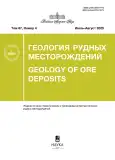The deposit belongs to the type of aposerpentinite gold-bearing "serpentine veins" and is localized in the thrust zone of NW dipping, separating the Dzhabyk-Karagay anticlinorium and the Sukhtelinsky synclinorium. Mineralization is controlled by the thrust zone of NW dipping and tension cracks mainly of SEE dipping, caused by the dynamic influence of this Dzhabyk granitoid massif during its formation. Ores are represented by poor sulfide sheared and brecciated talc-carbonate rocks. Ore talc-carbonate metasomatism is manifested in the sequential replacement of serpentinites by talc and carbonates (breunnerite, magnesite) and ends with the formation of veinlet dolomite, talc and antigorite. Ore minerals are represented by disseminated small particles of native gold, sulfides and sulfoarsenides of Cu, Fe, Ni, Co (pentlandite, chalcopyrite, violarite, ulmanite, millerite, gersdorffite-cobaltite), as well as sulfoarsenides of Ir (irarsite) and Pt (platarsite). The sulfur content in the ores does not exceed 0.02 wt.%. Grains of native gold (Au-Ag solid solution with a fineness of more than 910‰) are enclosed in serpentine, chlorite, talc, and less often carbonate; they are often confined to shear cracks in metasomatites. Serpentinites at a distance from the deposit are specialized in Ni, Co and Cr. In addition, talc-carbonate rocks are recorded to have higher contents of granitophile elements (W, Sn, Rb, Cs, U) compared to serpentinites. Antigorite veinlets contain Ni, Sb and Ta, talc – Ag, dolomite – Mn, Sr, Ba, REE, Pb, Mo, Bi and Cd. Thermocryometric study of fluid inclusions in carbonates has established that talc-carbonate metasomatites were formed in the temperature range of 400–200°С from fluids belonging to the salt systems H2O–NaCl, H2O–NaCl–NaHCO3 and H2O–NaCl (MgCl2) of low salinity (2.6–5.3 wt.% equiv. NaCl). Interpretation of the results of the oxygen and carbon isotope composition of carbonates (δ18O and δ13C, respectively, 19.2–24.2‰ and -7.3–8.5‰), as well as oxygen and hydrogen of serpentine, talc and chlorite (δ18O = 12.5…18.2‰, δD = -50.6…-68.0‰) indicates a metamorphic origin of the fluid. This fluid was formed as a result of the interaction of juvenile water with volcanogenic-sedimentary rocks enclosing the ultramafic massif. Participation of water released during the replacement of serpentine and talc by carbonates, as well as magmatic fluid genetically related to the Dzhabyk granitoid massif, is allowed. It is assumed that Cu, Fe, Ni, Co, Au, Pt, Ir in the ores were extracted by carbon dioxide fluid from ultrabasic rocks, and the increased contents of granitophile elements (W, Sn, Rb, Cs, U, etc.) are associated with the influx of magmatic fluid.
 397-415
397-415


 416-438
416-438


 439-460
439-460


 461-483
461-483


 484-506
484-506











